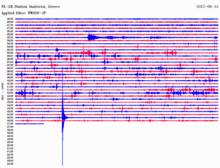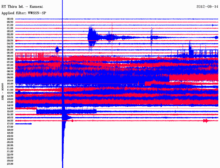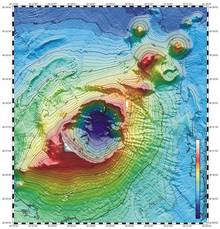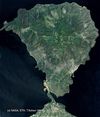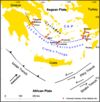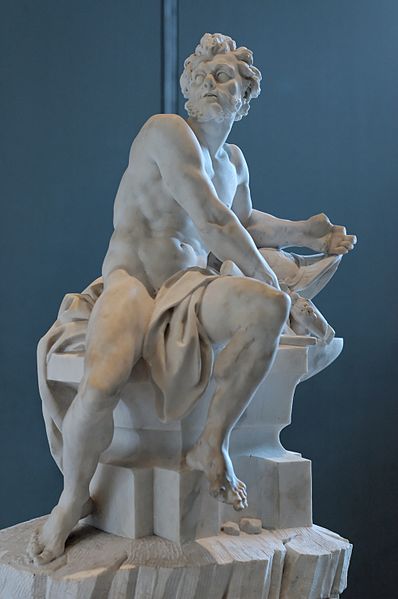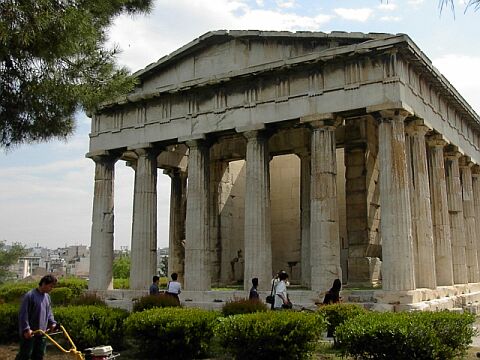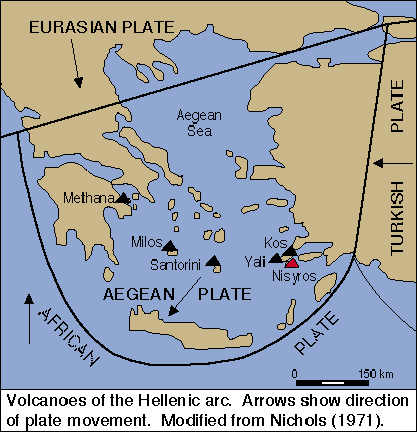
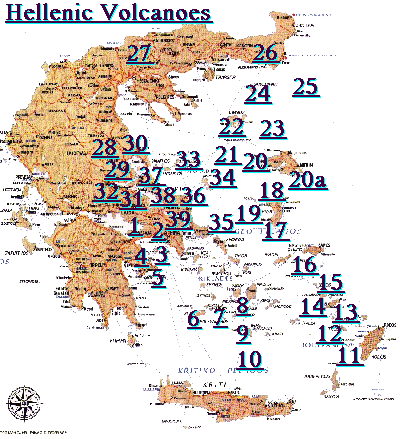
Dee Finney's blog
start date July 20, 2011
today's date September 18, 2012
page 303
TOPIC: THE GREEK VOLCANO GOD - MAGMA IS BUILDING UNDER THE
VOLCANO SANTORINI
DREAM - I was working in an engineering office. It seemed
like it might have been A-C (Allis-Chalmers)
I had not been working as many hours as I could. I took some sick time
the week before so my paycheck wasn't as large as I needed.
I went to work and was working on a chart about European volcanos and while I
was doing this, a man walked into the office who looked like a very tall grey
cat with a suit on. I knew he was the God of the Greek volcanos.
I worked very hard on my volcano charts along with answering phones, typing
up the engineering papers, etc.
I noticed later that I was very tall myself, and I had to duck down at least
4 inches to get through the doors.
Just as I was waking up, I was talking to one of the engineers about my lack
of education, but my knowledge and desire to know was greater than most women
who worked at my company, which gave me the will to work on the projects I did.
List of volcanoes in
Greece
From Wikipedia, the free encyclopedia
This is a list of active and extinct
volcanoes in
Greece.
References
|
News:
Join us on a relaxed walking and
study tour to get to know Santorini's geology and
natural history and much more with geologist Tom
Pfeiffer. There are free spaces for the 13-21 Oct trip!
[more]
Monday, Sep 10, 2012
Santorini is in the headlines again, some of course
saying that scientists detected evidence that Santorini
is going to erupt soon. ...
[more]
Santorini volcano unrest 2011/12:
During 2011 and the first months of 2012,
the number of earthquakes detected at Santorini has been
slightly above background levels. The quakes were
concentrated in the volcanically and tectonic active SW-NE
zone passing through the caldera and the submarine volcano
Kolumbus to the NE. An inflation of Nea Kameni has been
detected, suggesting that a magmatic intrusion took place.
As of June 2012, the volcanic unrest has calmed down, but we
will follow the developments closely and post updates on
this page.
Read also:
Santorini volcano - when will the next eruption occur?
Overall, seismic activity has been decreasing a lot on
Santorini - compare the recent plot of quakes around
Santorini with one from 2011 or early 2012.
What caused the inflation and quakes during 2011-early 2012
has stopped doing so at least for now. Most likely, that was
magma rising from depth into shallow reservoirs beneath Nea
Kameni (called an intrusion), and has now "settled" and is
slowly cooling without making it to the surface, i.e. erupt.
2.7 quake SW of Santorini - the seismic signal
Update Tue 14 Aug 19:12
This is what a (small) magnitude 2.7 earthquake in 25 km
distance at 20 km depth looks like on the seismograms of
Santorini and gives an idea about how sensitive they are.
You can see the quake at 16:07 in
today's earthquake list.
-
You +1'd this publicly.
Undo
-
www.webcamgalore.com/EN/webcam/Greece/Santorin/1715.htmlCached
You +1'd this publicly.
Undo

 |
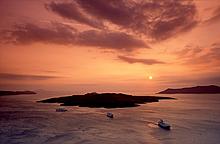
Sunset over the Nea Kameni volcano (c) Tobias Schorr
|
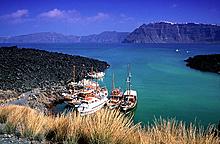
The Erinia bay at Nea Kameni island (c) Tobias
Schorr
|
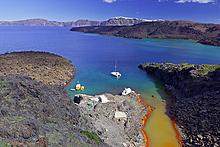
The bay with thermal water at Palea Kameni island
(c) Tom Pfeiffer
|
Santorini volcano
Caldera (complex stratovolcano) 329 m (on caldera rim) / 128 m
(top of most recent lava shield, Nea Kameni)
Cyclades, Greece, 36.4°N / 25.4°E
Current status: dormant (1 out of 5)
Santorini webcams / live data
Last update: 9 Aug 2012
Typical eruption style: Dominantly explosive, with
effusive activity during intervals. Powerful explosive,
so-called Plinian eruptions appear to occur every 10-30,000
years. Construction of lava shields and minor to irregularly
spaced subplinian explosive activity during interval times.
Santorini volcano eruptions: 1613 BC +-7 years (the
so-called "Minoan eruption", one of the largest plinian
eruptions during the past 10,000 years on earth)
historic eruptions: 197 BC, 46/47 AD, 726, 1570-1573, 1707-1711,
1866-1870, 1925-1928, 1939-1941, 1950
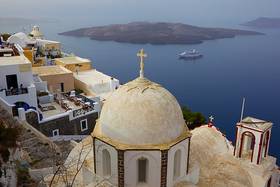 Santorini Volcano Photos
Last earthquakes nearby:
Santorini Volcano Photos
Last earthquakes nearby:
| Time |
Mag. / Depth |
Distance |
Location |
| Tue, 18 Sep |
| Tue, 18 Sep 06:03 UTC |
M 2.7 / 15 km |
7 km |
DODECANESE ISLANDS, GREECE |
html='Earthquake data:
2012-09-18 06:03:47 UTC
Mag. / depth: M2.7 / 15km
Lat / Long: 36.34 / 25.37 DODECANESE ISLANDS, GREECE.
Source: Sat, 15 Sep
| Sat, 15 Sep 15:17 UTC |
M 2.0 / 25.7 km |
17 km |
15 Km S from Santorini |
| Thu, 13 Sep |
| Thu, 13 Sep 14:14 UTC |
M 2.4 / 112.2 km |
8 km |
5 Km E from Santorini |
| Thu, 6 Sep |
| Thu, 6 Sep 11:32 UTC |
M 1.4 / 6.1 km |
1 km |
4 Km WNW from Santorini |
| Mon, 27 Aug |
| Mon, 27 Aug 04:24 UTC |
M 1.6 / 14.5 km |
24 km |
23 Km SSW from Santorini |
View all recent quakes
Santorini is a volcanic Island group at the central south end of the
Cyclades in the Aegean Sea (Greece). As a popular tourist destination in
Greece, it is renowned for its spectacular sea-filled volcanic caldera
sourrounded by steep colorful cliffs, the
beauty of its villages and fields.Background:
The island group of Santorini is the most well-known and active volcanic
centre of the Hellenic Volcanic Arc in the south Aegean Sea. It is a
very complex stratovolcano dominated by a large, sea-flooded caldera
created by several large explosive eruptions. The different products of
about 2 million years of volcanic activity have accumulated around a
small non-volcanic basement, that once formed a small island similar to
the other cycladic islands. Most of the volcanic layers are visible in
the multi-colored sequences of the impressive steep inner walls of the
caldera, striking the visitor who reaches the island by boat.The last
eruption took place in an phreatic eruption on Nea Kameni island in
1950.
The Minoan Eruption
Santorini's volcanic activity during the past 2-500,000 years has been
dominated by very large explosive eruptions at intervals of few tens of
thousands of years. The most recent of this type occurred at around 1613
BC and is known as the so-called Minoan eruption. The late Bronze Age
eruption, one of the biggest known volcanic explosions in younger time,-
and one of the most studied, but still most mysterious eruptions of all
time-, devastated not only Santorini, but had a deep impact on the whole
of the Eastern Mediterranean. Perhaps it even had serious world-wide
effects and changed history.
Still today, one can see its deposits, the characteristic, tens of
meters thick layer of white pumice and ash that blankets most of the
surface of the island group. The eruption changed the shape of the
island itself dramatically: it is now believed that before the eruption,
it had the shape of an almost complete ring that enclosed an earlier,
shallower caldera. Then, large sections of island collapsed into the
emptied magma chamber after the eruption, literally disappearing under
the sea. The ring-island was breached to the W and NW, and the caldera
was significantly widened and deepened.
The Minoan eruption devastated the rich, highly developed economic
center, that Santorini was at that time. Since 1969, intense
archaeological excavations have brought to light an important
Cycladic/Minoan town which had been buried beneath the volcanic ash for
almost 4000 years. Although it appears that people had time to evacuate
their island in time before the eruption, carrying most of their goods
with them, the findings from Akrotiri are impressive: especially, they
include well-preserved and magnificent wall paintings, ceramics and
other objects. Thanks to the work of numerous archaeologists, a new
light was thrown on an important prehistoric period and culture. The
spectacular discovery even induced continuing speculations that relate
the volcanic destruction of Santorini to the legend of the sunken
Atlantis.
The historic eruptions of Santorini volcano (Palea and Nea Kameni)
Although at present dormant, Santorini has been active several times in
historic time. Since its last major explosive eruption (at about 1645
BC) numerous minor and medium-sized, mainly effusive eruptions have
occurred. This activity built the dark-colored islands of Nea and Palea
Kameni inside the caldera. Their first appearance was witnessed and
reported by Greek and Roman writers. The last eruption on Nea Kameni
occurred in 1950. At present, Santorini is dormant, and volcanism
manifests as fumarolic activity and hot springs around the islands.

Blick auf Ia mit Oster-Beflaggung. (Photo: Tobias Schorr)
|

Daisies and the caldera near Akrotiri (Photo: Tom Pfeiffer)
|

The contact between the metamorphic basement and volcanic
rocks (Photo: Tom Pfeiffer)
|

Spring-time flowers and the caldera (Photo: Tom Pfeiffer)
|

Natrolith crystals (zeolithe) from Ia village/Santorini,
29.03.2012 (Photo: Tobias Schorr)
|

Orchid (Ophrys papilionacea?) form the Mavro Vouno at the
village Ia/Santorini, 29.03.2012 (Photo: Tobias Schorr)
|
1950 eruption
10. Jan. 1950 - 2. Feb. 1950: Small effusive activity ("Liatsikas"
lavas) preceded by phreatic explosions.
More info
1939-41 eruption
20. Aug. 1939 - July 1941 -- Formation of several lava domes
("Tritona", "Ktenas", "Fouqué", "Smith-Reck" and "Niki"). Extrusive
and slighly explosive activity. Lava outflow in most cases preceeded
by phreatic explosions.
more info
1925-28 eruption
11. Aug. 1925- 17. March 1928 -- Moderate effusive and explosive
activity. Growth of Nea Kameni. Lava flows, lava fountains and
ash-falls.
- Aug. 1925 -- Rising temperature in the Red bay ("Kokkina Nera",
gr. = red waters) at the eastern shore of Nea Kameni and subsidence
of Nea Kameni's east shore. Vapor fountains and lava outflow. ... more
1866-1870 eruption
4. Feb. 1866 - 15. Oct. 1870 -- Moderate effusive and minor
explosive activity. Mikri and Nea Kameni unite. Lava flows, lava
fountains and ash-falls. ... more
1711 - 1866 activity
No volcanic activity occurred during 1711-1866. Mikri and Nea Kameni
were 2 separated islands forming 2 natural bays (Georgios and
Vulkano bay). Sulfuric fumaroles in Vulkano bay. Building of a small
harbor and ca. 50 summerhouses (!) on Nea Kameni.
1707-1711 eruption: Nea Kameni appears
23. May 1707 - Sept. 1711 -- Formation of Nea Kameni (gr., = "the
new burnt island"). Strong surtseyan and effusive activity. Ash-fall
and gas explosions. Lowering of the coastline of Thera and Mikri
Kameni. ... more
1650 Kolumbo volcano eruption
27. Sept 1650 -- Kolumbo submarine volcano (ca. 8 km NE of Cape
Kolumbo, Santorini): strong surtseyan-subplinian eruption with ash
and pumice fall, toxic gasses (>50 fatalities). Generation of a
strong tsunami.
more info on
Kolumbo volcano
1570 eruption: Mikri Kameni Island appears
Formation of Mikri Kameni (gr., = "small burnt island"). Surtseyan
activity, ash-fall and block fall-out accompany the formation of a
lava dome which rises above sea level to form the new island Mikri
Kameni.
1457-1458 activity
Unclear reports from Athanasius Kircher (1665) and Buondelmonte
(1465/66) indicate that either a part of Palea Kameni collapsed and
disappeared or a new island between Palea Kameni and Thera was
built.
726 AD subplinian (?) eruption
Strong explosive probably sub-plinian eruption. Records by
Nicephoros (758-823), Theophanes (752-818) and Cedremus (after
1059). Probably small effusive activity following the pumice
eruption creating the black blocky lava lobe at Agios Nikolaos (the
small harbor bay with the church and hot iron springs).
46 - 726 AD activity
No reports of activity are known from that period. There was either
actually no eruption or it has not been recorded.
46 AD eruption - appearance of a new island
Appearance of a new island that probably grew together with Hiera
and formed the basis of Palea Kameni. Descriptions by Roman
historians Seneca (4 BC-65 AD), Livy (59 BC-AD 17), Pliny the Elder
(23-79 AD), Dio Cassius (ca. 200 AD), Aurelius Victor (4th century
AD), Philostratos (ca. 200 AD), Orosius (5th century AD),
Cassiodorus. (418-562 AD), Labbreus (1670). Probably surtseyan
activity with updoming of the sea-floor.
197 BC eruption: appearance of Palea Kameni
Formation of an island called Hiera (gr., = "the holy one") inside
the caldera, probably a precursor of Palea Kameni. Documented by
greek and Roman writers: Strabo (66BC - 24 AD), Plutarch (ca. 40-120
AD), Pausanias (ca.120 AD), Justinus (2nd century AD), Eusebius from
Cesarea (270-340 AD) and Ammianus Marcellinus (ca. 330-400 AD).
Probably surtseyan activity with updoming of the sea-floor
(comparable with the 1707-1711 events).
1613 +- 13 BC Minoan eruption
The most recent plinian eruption on Santorini occurred in the late
Bronze Age at around 1613 BC and is known as the so-called Minoan
eruption. It is one the biggest known volcanic explosions in younger
time,- and one of the most studied, but still most mysterious
eruptions of all time-. It devastated not only Santorini, but had a
deep impact on the whole of the Eastern Mediterranean. Perhaps it
even had serious world-wide effects and changed history.
Size of the Minoan eruption
Dating of the Minoan eruption
Still today, one can see its deposits, the characteristic, tens of
meters thick layer of white pumice and ash that blankets most of the
surface of the island group. The eruption changed the shape of the
island itself dramatically: it is now believed that before the
eruption, it had the shape of an almost complete ring that enclosed
an earlier, shallower caldera.
Large sections of island collapsed into the emptied magma chamber
after the eruption, literally disappearing under the sea. The
ring-island was breached to the W and NW, and the caldera was
significantly widened and deepened.
The Minoan eruption devastated the rich, highly developed economic
center, that Santorini was at that time. Since 1969, intense
archaeological excavations have brought to light an important
Cycladic/Minoan town which had been buried beneath the volcanic ash
for almost 4000 years. Although it appears that people had time to
evacuate their island in time before the eruption, carrying most of
their goods with them, the findings from Akrotiri are impressive:
especially, they include well-preserved and magnificent wall
paintings, ceramics and other objects. Thanks to the work of
numerous archaeologists, a new light was thrown on an important
prehistoric period and culture. The spectacular discovery even
induced continuing speculations that relate the volcanic destruction
of Santorini to the legend of the sunken Atlantis.
Further information / links:
 |
Santorini Decade Volcano /
www.decadevolcano.net/santorini/santorini.htm |
|
Tom's private website
about Santorini, Etna and other volcanoes. Contains a huge
archive of volcano photos, information and other stuff. |
|
|
Tuesday, Dec 13, 2011
At 19h22 GMT (21h22 local time), a 3.2 earthquake
occurred at the little-known submarine volcano Kolumbos
ca. 8 km NE of Santorini, Island, Greece. This marks one
of the largest events in recent months. ...
[more]
Kolumbo volcano
submarine volcano -18 m / -60 ft
Greece, 36.52°N / 25.49°E
Current status: dormant (1 out of
5)
Last update: 13 Dec 2011
Typical eruption style: explosive
Kolumbo volcano eruptions: 1650
 Last earthquakes nearby:
Last earthquakes nearby:
| Time |
Mag. / Depth |
Distance |
Location |
| Sat, 15 Sep |
| Sat, 15 Sep 06:13 UTC |
M 1.9 / 14.3 km |
23 km |
31 Km E from Ios |
| Fri, 14 Sep |
| Fri, 14 Sep 12:41 UTC |
M 1.4 / 22.7 km |
25 km |
35 Km ENE from Santorini |
| Tue, 11 Sep |
| Tue, 11 Sep 21:57 UTC |
M 1.3 / 3.7 km |
8 km |
17 Km SSE from Ios |
| Thu, 6 Sep |
| Thu, 6 Sep 22:18 UTC |
M 1.3 / 14.5 km |
23 km |
22 Km E from Ios |
| Thu, 6 Sep 09:06 UTC |
M 0.9 / 14.9 km |
23 km |
31 Km SW from Amorgos |
View all recent quakes
Kolumbo (or Kolumbos) volcano is an active submarine volcano located
8 km NE of Santorini Island in the Aegean Sea. The volcano forms an
elliptical SW-NE elongated 3 km wide cone with a 500 m deep and
1.5 km wide crater, whose rim's highest parts rise to 18-15 m
beneath sea level.
The crater floor, in particular in its northern part, contains a
large and very active high-temperature fumarole field.
The crater of Kolumbo volcano is a small caldera which could have
(at least in parts) formed during the volcano's only known, but very
violent last eruption which occurred in 1650 AD. Background:
The large hydrothermal field in the northern part of the caldera at
about 500 m depth contains a massive Kuroko-style sulfide deposit.
Only few such deposits are known world-wide and they are of great
interest, especially because of the typically high content of gold
and silver in the sulfides. In 2010, the exploration
Vessel (E/V) Nautilus discovered steep, up to 6 m high chimneys
of sulfides above one of the vents.
1650 eruption of Kolumbo volcano
The 1650 eruption was a very explosive event and ejected pumice and
ash as far as Turkey, and produced pyroclastic flows that killed
about 70 people on Santorini. During the eruption, it constructed a
temporary island (hence it's name Kolumbo, in Greece "swimming"). A
tsunami occurred as well, probably during the collapse of the cone.
It caused damage on nearby islands up to 150 km and invaded the flat
coastal areas especially on the eastern side of Santorini, where
ruins from Roman times were uncovered. The eruption also caused
damage killed a great number of livestock because of poisonous
gasses, mainly H2S.
Links:
-
Thera 2006 Expedition Summary (NOAA Ocean Explorer)
-
Special Volume of Oceanography(pdf)
- <linkhttp://www.nautiluslive.org/>Follow Dr. Robert Ballard and
his team as
they explore the ocean on the E/V Nautilus
|
|
 |
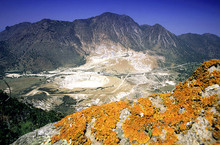
The Nisyros volcano caldera with its hydrothermal
eruption centers in the middle
(Stefanos crater, Polyvotis crater). Foto:Tobias
Schorr 2000 |
More info:
 |
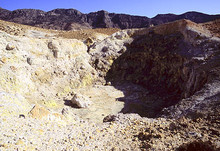
Micros Polyvotis crater
|
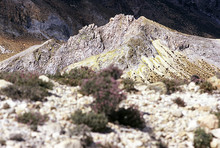
Polyvotis volcano dome
|
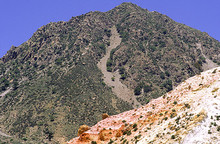
Profitis Ilias volcano dome
|
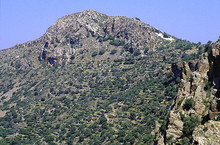
Akimaronas volcano dome
|
Nisyros volcano
Stratovolcano, volcanic domes 680 m
Dodecanese Islands, Greece, 36.58°N / 27.17°E
Current status: dormant (1 out of
5)
Typical eruption style: Hydrothermal explosions,
effusive volcano, volcano domes
Nisyros volcano eruptions: 1881-1887 -
hydrothermic explosions of the crater "Micros Polyvotis"
1500 - hydrothermic explosions
1000-2000 B.C. - hydrothermic explosions of the
crater "Stefanos"
5000-10.000 B.C. - hydrothermic eruptions of the
Kaminakia craters
15.000-10.000 B.C. - building of postcalderic volcano
domes
15.000 B.C. - effusive eruption of the central
caldera of Nisyros ("Upper pumice")
25.000 B.C. - effusive eruption of the central
caldera of Nisyros ("Lower pumice")
40.000-30.000 B.C. - effusive eruption
("Kira-Formation")
150.000 B.C. - first submarin eruptions
Nisyros Volcano Photos
Last earthquakes nearby:
| Time |
Mag. / Depth |
Distance |
Location |
| Sun, 16 Sep |
| Sun, 16 Sep 22:19 UTC |
M 1.4 / 10.2 km |
18 km |
ONIKI ADALAR (Mediterranean SEA) |
| Thu, 13 Sep |
| Thu, 13 Sep 20:26 UTC |
M 2.5 / 18.1 km |
10 km |
6 Km N from Nissiros |
| Wed, 5 Sep |
| Wed, 5 Sep 23:44 UTC |
M 2.4 / 109.4 km |
27 km |
28 Km WSW from Nissiros |
| Tue, 28 Aug |
| Tue, 28 Aug 20:07 UTC |
M 2.0 / 23 km |
20 km |
DODECANESE ISLANDS, GREECE |
| Fri, 24 Aug |
| Fri, 24 Aug 20:26 UTC |
M 2.4 / 16.2 km |
12 km |
14 Km SW from Nissiros |
View all recent quakes
The small round island of Nisyros is one of the more active but less
known volcanoes in Greece. It is located south of the popular beach
holiday island of Kos.
The volcano is part of the Hellenic Arc, a curved line of volcanic
centers which are caused by a subduction zone, and stretches from
the Saronic Gulf opposite Athens via the island groups of Milos,
Santorini, and Nisyros-Yali-Cos to the Bodrum peninsula at the
extreme SW of Turkey.
The last eruption of Nisyros were phreatic explosions in 1881-87.
They left a moonscape with colorful craters and very active
fumaroles. Background:
Nisyros is together with the volcanoes of the Cos caldera the east
edge of the Aegean Arch with its active volcanoes Methana, Milos,
Santorini. The Nisyros volcano is the most active remain of the Cos
caldera that exploded aprox. 150.000 years ago. Nisyros, Yali,
Strongyli, Pyrgoussa, Pahia and Kefalos (at Cos) are the remains of
a zone that is considered to be still active. A Magma chamber below
Nisyros is only 3-4 km deep and still rising up. Since 2000 when the
Nisyros research program of the GEOWARN-Team started, the
temperatures of the fumaroles have been changing from 98 C to 103 C
in 2004. There was also a high tectonic (earthquakes) activity in
the last years and so a program to prevent volcanic hazards is still
ongoing. Nisyros is a very interesting place (not only) for
geologists, because here you can
study all kinds of volcanic rocks and you can even walk into the
biggest hydrothermic crater on earth. Also the nature is a great
thing to discover. Walking in the beautyful mountains is something
unforgetable!

One of the best Garnet crystals found in Spetember 2010
on Nisyros. It was fixed in a rock of skarn. Very rare
sample from Greece! (Photo: Tobias Schorr)
|

Ancient, corinthian columns on the acropolis Paliocastro
at Mandraki/Nisyros (Photo: Tobias Schorr)
|

Spring flowers in front of the ancient castle
Paliocastro at Mandraki/Nisyros. (Photo: Tobias Schorr)
|

Hot drops of sulfuric acid at a fumarole of Stefanos
crater on Nisyros volcano, Greece (Photo: Tobias Schorr)
|

The Stephanos crater seen from Nikia village (c)
|

Fumaroles and colored rocks at the side of the crater.
(c)
|
3D-Image of the area of Cos & Nisyros
 |
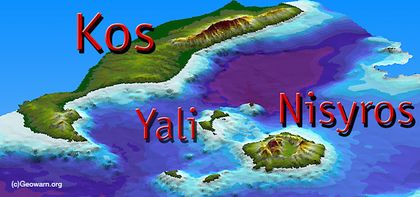
Threedimensional image of the caldera of Cos with
its volcanoes Yali & Nisyros
|
|
|
Milos volcano
stratovolcanoes, phreatic craters, lava domes 748 m
Greece, 36.67°N / 24.48°E
Current status: dormant (1 out of 5)
Typical eruption style: Explosive, hydrothermal
explosions
Milos volcano eruptions: 70.000 - 90.000 years ago
(Tsingrado volcanic craters)
No known volcanic activities in historic times, but strong
geothermal activity
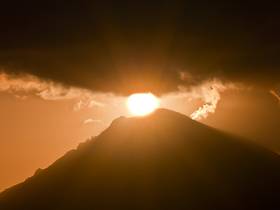 Milos Volcano Photos
Last earthquakes nearby:
Milos Volcano Photos
Last earthquakes nearby:
| Time |
Mag. / Depth |
Distance |
Location |
| Sun, 9 Sep |
| Sun, 9 Sep 07:26 UTC |
M 4.2 / 126.6 km |
15 km |
10 Km NNE from Milos |
| Sat, 25 Aug |
| Sat, 25 Aug 22:56 UTC |
M 1.9 / 14.1 km |
19 km |
11 Km NW from Milos |
| Sun, 19 Aug |
| Sun, 19 Aug 10:09 UTC |
M 2.4 / 2.2 km |
20 km |
11 Km NW from Milos |
| Sat, 28 Jul |
| Sat, 28 Jul 23:31 UTC |
M 3.1 / 64 km |
28 km |
SOUTHERN GREECE |
View all recent quakes
Milos is a volcanic island in the southern Aegean Sea and well known for
its extensive mineral deposits and fine beaches. It is part of the
Hellenic volcanic arc, that also comprises the volcanic islands of
Santorini and Nisyros. Considered dormant, Milos presents strong
hydrothermal activity, caused by subduction of the African under the
Aegean plate.Background:
Milos is a mainly volcanic island (like the neighbour islands of
Kimolos, Polyaigis, Antimilos, Glaronisia and Akradia islands). Some
older metamorphic rocks are exposed, that were formed many millions of
years before the existence of the island (schists, prasinites,
calc-schists, etc.). Later these layers were covered by sea-sediments.
Volcanism on Milos started in upper Pliocene and continued until late
Pleistocene. The last volcanic eruptions on Milos (90.000 B.C.) took
place in the area of Tsingrado volcano. Volcanicm on Milos is similar to
the other parts of the Hellenic Volcanic Arc comprising also Methana,
Santorini and Nisyros.
It is caused by the geodynamic convergence of the African and Aegean
plates. The collission and subduction of the African plate produces
calcalkalines (andesitic, dacitic) magmas and rocks. The eruptive phases
on Milos produced mainly acidic tuffs & pumice, pyroclastic flow and
lahar deposits. During extrusive phases a number of andesitic volcanic
domes were built and some lavaflows emplaced. Towards the "end" of the
most recent volcanic activity many phreatic explosions produced small
craters (like near Agia Kyriaki or Achivadolimni) visible still today.
Most of the volcanic rocks on Milos were strongly hydrothermally
altered, which makes Milos become an important supplier for mining
minerals like baryte, silver, perlite, caolin, bentonite and in the
future perhaps even gold (Hontrovouno).
Studies show the presence of a high-temperature hydrothermal system
(up to 310 deg. C) below the island, responsible for the abundance of
active fumaroles (e.g. in the Kalamos area). This reservoir might be
related to an active magma chamber and therefore, future volcanic
activity on the island can not be excluded.

Pebble at Paliohori beach (Photo: Tobias Schorr)
|

Wild sea and the fisher houses at Klima (Photo: Tom
Pfeiffer)
|

Sculpured shoreline at Sarakiniko (Photo: Tom Pfeiffer)
|

Nice plants at the beach near Mytikas (Helichrysum rupestre
(?) (Photo: Tobias Schorr)
|

Red poppies on a field near Adamas, Milos (Photo: Tom
Pfeiffer)
|

Red poppies on a field near Adamas, Milos (Photo: Tom
Pfeiffer)
|
|
|
Methana volcano
32 Lava domes 740 m
Greece, 37.62°N / 23.34°E
Current status: dormant (1 out of
5)
Typical eruption style: Effusive, construction of
lava domes, flowing through karstic systems, hydrothermal
explosions.
Today: Only hydrothermic activity
(Methana-Volcanic-Spa).
Methana volcano eruptions:
1700:
Submarine volcano "Pavsanias" aprox. 1,5 km
north-west of the historic volcano.
240-230 B.C.:
Historic eruption near the
village Kameni Hora that was described by ancient writers
like STRABON, OVID and PAUSANIAS;
Every 2000 - 12.000 years: Eruptions on mayor fault
systems.
10.000-30.000 B.C.: Building of the central volcano
domes
100.000-600.000 B.C.: Building of the volcano domes
in the eastern part of Methana.
1.500.000 years ago: First submarine eruptions
(pillowlavas boninite from Agios Nikolaos)
Methana Volcano Photos
Last earthquakes nearby:
| Time |
Mag. / Depth |
Distance |
Location |
| Tue, 18 Sep |
| Tue, 18 Sep 05:15 UTC |
M 1.3 / 14.5 km |
27 km |
28 Km WNW from Idhra |
| Sat, 8 Sep |
| Sat, 8 Sep 03:21 UTC |
M 1.1 / 21.4 km |
8 km |
16 Km S from Aigina |
| Sat, 8 Sep 02:34 UTC |
M 1.3 / 22.6 km |
3 km |
14 Km SW from Aigina |
| Thu, 6 Sep |
| Thu, 6 Sep 15:43 UTC |
M 1.3 / 18.3 km |
20 km |
11 Km WNW from Aigina |
| Wed, 5 Sep |
| Wed, 5 Sep 00:49 UTC |
M 0.8 / 25.6 km |
14 km |
23 Km S from Aigina |
View all recent quakes
Methana is the northwestern part of the active, Greek volcanoes. It
is a part of the Hellenic Arc with its volcanoes Milos, Santorini
and Nisyros. It contains about 32 lava domes, the youngest one of
which formed around 238 BC as recorded by Greek and Roman historians
(e.g. Pausanias).
The peninsula is famous for its hot springs. Background:
On Methana the last activities have been recorded at 1700 in a
submarin part north of Kameni Hora. On Methana there are about 32
volcanoes. The activity began about 1-2 million years ago. There are
different kinds of volcanoes on Methana. Some are explosive, some
are domes and some are only hdrothermal craters or lava flows
through karstic systems. The hydrothermal activity is shown mostly
on a west-east fault that runs through the town of Methana. There
are also the thermal baths and mofettes (gas). Methana has been
researched by a group of geologists of the Swiss
university ETH and the Greek geological survey IGME.
(1991-1995). The result were two maps in the size 1:25.000
(geological and topographical maps). 3D-Maps you can find here!

View from Agios Panteleimonas towards the town of
Methana (Photo: Tobias Schorr)
|

The village of Pano Mouska on the eastern side of
Methana, Greece (Photo: Tobias Schorr)
|

mouska_city.jpg (Photo: Tobias Schorr)
|

methanal__20090627_4300.jpg (c)
|

methana_tom_vulk_20090426_2986.jpg (c)
|

methanal__20090627_4283.jpg (c)
|
Reading:
Dietrich, V.J. , Mercolli, I. and
Oberhänsli, R. , 1988, Dazite,
High-Alumina Basalte und Andesite als Produkte Amphibol dominierter
Differentiation (Aegina und Methana, nördlicher
Inselbogen). Schweiz. mineral. petrogr. Mitt. 68/1. 21-39.
Dietrich, V.J. , Hurni, L. and
Gaitanakis, P. , 1995: Geological Map of
Greece. Methana (Saronic Gulf), 1:25'000 with expl..
Stiftung Vulkaninstitut Immanuel Friedlaender, ETH-Zurich and IGME
(Athen).
Georgalas, G.C. , 1962,
Catalogue of the active volcanoes of the world
including solfatara fields; Part XII Greece:
International Association of Volcanology, Rome, Italy, 40 p.
Mee, C.B. , and Forbes, H.A. (eds.),
1997, A Rough and Rocky Place: The Landscape
and Settlement History of the Methana Peninsula, Greece.
Liverpool University Press.
Simkin, T. , and Siebert, L. , 1994,
Volcanoes of the World:
Geoscience Press, Tucson, Arizona, 349 p.

Further information / links:
 |
Methana.com
/ www.methana.com |
|
A large private website
with comprehensive information about the volcanic peninsula of
Methana, with lots of information, photographs and other
material about its geology, geography, history, flora and fauna
etc.. Created and maintained by VOLCANO DISCOVERY team member
Tobias Schorr. |
|
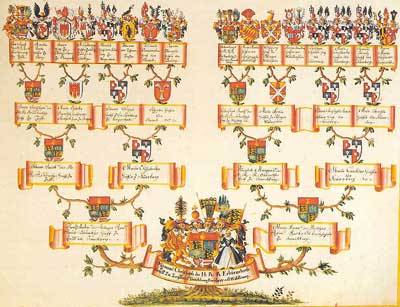
GREEK GOD FAMILY TREE
THE GREEK VOLCANO GOD
-
en.wikipedia.org/wiki/Hephaestus
You +1'd this publicly.
Undo
-
en.wikipedia.org/wiki/Vulcan_(mythology)
You +1'd this publicly.
Undo
-
www.theoi.com/Olympios/HephaistosGod.html
You +1'd this publicly.
Undo
-
You +1'd this publicly.
Undo
-
www.greatdreams.com/myth.htm
You +1'd this publicly.
Undo
-
www.greatdreams.com/mojave.htm
You +1'd this publicly.
Undo
-
www.greatdreams.com/solar/sun.htm
You +1'd this publicly.
Undo
-
www.greatdreams.com/connect.htm
You +1'd this publicly.
Undo
-
www.greatdreams.com/Events/9_11_01/Amtrgrev.htm
You +1'd this publicly.
Undo
-
www.greatdreams.com/11_11c.htm
You +1'd this publicly.
Undo
-
www.greatdreams.com/blog-2012/dee-blog187.html
You +1'd this publicly.
Undo
-
www.greatdreams.com/dna_database.htm
You +1'd this publicly.
Undo
-
www.greatdreams.com/constellations/ursas-bootes.htm
You +1'd this publicly.
Undo
-
www.greatdreams.com/A_STAR_NAMED_HADES.htm
You +1'd this publicly.
Undo
-
www.greatdreams.com/alex/sacred-birds.htm
You +1'd this publicly.
Undo
-
www.greatdreams.com/myth/weaving.html
You +1'd this publicly.
Undo
-
www.greatdreams.com/war/weapons_of_war.htm
You +1'd this publicly.
Undo
-
www.greatdreams.com/fire_database.htm
You +1'd this publicly.
Undo
-
www.greatdreams.com/radio/oz/ozradio.htm
You +1'd this publicly.
Undo
-
www.greatdreams.com/constellations/sirius-to-atlas.htm
You +1'd this publicly.
Undo
-
www.greatdreams.com/blog-2012-2/dee-blog274.html
You +1'd this publicly.
Undo
-
www.greatdreams.com/constellations/star_named_Hades.htm
You +1'd this publicly.
Undo
-
www.greatdreams.com/blog-2012/dee-blog177.html
You +1'd this publicly.
Undo
-
www.greatdreams.com/crop/trinity_crop.htm
You +1'd this publicly.
Undo
Hephaestus - Vulcan
Hephaestus (
/hɪˈfiːstəs/,
/həˈfɛstəs/
or
/hɨˈfɛstəs/;
8 spellings;
Ancient Greek Ἥφαιστος Hēphaistos)
was the
Greek god of
technology,
blacksmiths,
craftsmen,
artisans,
sculptors,
metals,
metallurgy,
fire and
volcanoes.[1]
Hephaestus'
Roman equivalent was
Vulcan. In Greek mythology, Hephaestus was the son of
Zeus and
Hera, the King and
Queen of the Gods.
As a smithing god, Hephaestus made all the weapons of the gods in Olympus. He
served as the blacksmith of the gods, and was worshipped in the manufacturing
and industrial centres of Greece, particularly
Athens. The
cult of Hephaestus was based in
Lemnos.[2]
Hephaestus's symbols are a smith's
hammer,
anvil, and a pair
of tongs.
Epithets
Hephaestus is given many
epithets. The
meaning of each epithet is:[3]
- Amphigúeis “the lame one” (Ἀμφιγύεις)
- Kullopodíōn “the halting” (Κυλλοποδίων)
- Khalkeús “coppersmith” (Χαλκεύς)
- Klutotékhnēs “renowned artificer” (Κλυτοτέχνης)
- Polúmētis “shrewd, crafty” or “of many devices” (Πολύμητις)
-
Aitnaîos “Aetnaean” (Αἰτναῖος),
owing to his workshop being supposedly located below
Mount
Aetna.[4]
Mythology
The craft of
Hephaestus
Hephaestus had his own palace on Olympus, containing his workshop with anvil
and twenty bellows that worked at his
bidding.[5]
Hephaestus crafted much of the magnificent equipment of the gods, and almost any
finely-wrought metalwork imbued with powers that appears in Greek myth is said
to have been forged by Hephaestus. He designed
Hermes' winged
helmet and sandals, the
Aegis
breastplate,
Aphrodite's
famed girdle,
Agamemnon's
staff of office,[6]
Achilles'
armor, Heracles'
bronze
clappers,
Helios' chariot (and one for himself, to be used on account of his
lameness), the shoulder of
Pelops, and
Eros' bow and arrows. In later accounts, Hephaestus worked with the help of
the chthonic
Cyclopes—among
them his assistants in the forge, Brontes, Steropes and Pyracmon.[7][8]
Hephaestus also built
automatons
of metal to
work for him. This included tripods that walked to and from
Mount
Olympus. He gave to the blinded
Orion his apprentice
Cedalion as
a guide.
Prometheus stole the fire that he gave to man from Hephaestus's forge.
Hephaestus also created the
gift that the gods gave to man, the woman
Pandora and
her pithos.
Being a skilled blacksmith, Hephaestus created all the thrones in the Palace of
Olympus.[9]
Parentage
From Homer's
Odyssey,
the Iliad,
and some Attic vase paintings, we know that Hephaestus was born of the union of
Zeus and Hera.[10]
In another tradition, attested by
Hesiod, Hera
bore Hephaestus alone.[11]
In Hesiod's
Zeus-centered cosmology, Hera gave birth to Hephaestus as revenge at Zeus for
his asexual birthing of
Athena. Several
later texts support Hesiod's account, for instance
Bibliotheke.[12],
Hyginus, and the preface to
Fabulae. However, in the account of Attic vase-painters, Hephaestus was
present at the birth of Athena and wields the axe with which he split Zeus' head
to free her. In the latter account, Hephaestus is there represented as older
than Athena, so the mythology of Hephaestus is inconsistent in this respect.
Fall from Olympus
In one branch of Greek mythology, Hera ejected Hephaestus from the heavens
because he was "shrivelled of foot". He fell into the ocean and was raised by
Thetis (mother
of Achilles) and the
Oceanid
Eurynome.[13]
In another account, Hephaestus, attempting to rescue his mother from Zeus'
advances, was flung down from the heavens by Zeus. He fell for an entire day and
landed on the island of
Lemnos, where
he was cared for and taught to be a master craftsman by the
Sintians—an
ancient tribe native to that island.[14]
(Hom. Il. i. 590, &c. Val. Flacc. ii. 8.5; Apollod. i. 3. § 5, who, however,
confounds the two occasions on which Hephaestus was thrown from Olympus.) Later
writers describe his lameness as the consequence of his second fall, while Homer
makes him lame and weak from his birth.
Return to Olympus
Hephaestus was the only Olympian to have returned to Olympus after being
exiled.
In an archaic story,[15]
Hephaestus gained revenge against Hera for rejecting him by making her a magical
golden throne, which, when she sat on it, did not allow her to stand up.[16]
The other gods begged Hephaestus to return to Olympus to let her go, but he
refused, saying "I have no mother".[17]
At last
Dionysus, sent to fetch him, shared his wine, intoxicating the smith, and
took him back to Olympus on the back of a mule accompanied by revelers—a scene
that sometimes appears on painted pottery of Attica and of Corinth.[18]
In the painted scenes the padded dancers and phallic figures of the Dionysan
throng leading the mule show that the procession was a part of the
dithyrambic celebrations that were the forerunners, in Athens, of the
satyr plays
of the fifth century.[19]
The theme of the return of Hephaestus, popular among the Attic
vase-painters whose wares were favored among the
Etruscans, may have introduced this theme to Etruria.[20]
In the vase-painters' portrayal of the procession, Hephaestus was mounted on a
mule or a horse, with Dionysus holding the bridle and carrying Hephaestus' tools
(including a
double-headed axe).
The traveller
Pausanias reported seeing a painting in the temple of Dionysus in Athens,
which had been built in the 5th century but may have been decorated at any time
before the 2nd century CE. When Pausanias saw it, he said:
There are paintings here – Dionysus bringing Hephaestus up to heaven. One
of the Greek legends is that Hephaestus, when he was born, was thrown down
by Hera. In revenge he sent as a gift a golden chair with invisible fetters.
When Hera sat down she was held fast, and Hephaestus refused to listen to
any other of the gods save Dionysus – in him he reposed the fullest trust –
and after making him drunk Dionysus brought him to heaven.
— Pausanias, 1.20
Consorts and
children
According to most versions, Hephaestus's consort is Aphrodite/a>,
who is is unfaithful to Hephaestus with a number of gods and mortals, including
Ares. However, in
Homer's Iliad,
the consort of Hephaestus is a lesser Aphrodite,
Charis "the grace" or
Aglaia "the
glorious"—the youngest of the
Graces, as
Hesiod calls her.[21]
In Athens,
there is a
Temple of Hephaestus, the Hephaesteum (miscalled the "Theseum") near
the agora. An
Athenian
founding myth tells that the city's patron goddess,
Athena, refused
a union with Hephaestus because of his unsightly appearance and crippled nature,
and that when he became angry and forceful with her, she disappeared from the
bed. His ejaculate fell on the earth, impregnating
Gaia, who subsequently gave birth to
Erichthonius of Athens.[22]
A surrogate mother later gave the child to Athena to foster, guarded by a
serpent.
On the island of Lemnos, Hephaestus' consort was the sea
nymph
Cabeiro, by whom he was the father of two metalworking gods named the
Cabeiri. In
Sicily, his consort was the nymph
Aetna,
and his sons were two gods of Sicilian
geysers called
Palici. With
Thalia, Hephaestus was sometimes considered the father of the
Palici.
Hephaestus fathered several children with mortals and immortals alike. One of
those children was the robber
Periphetes.
This is the full list of his consorts and children according to the various
accounts:
-
Aphrodite
- Aglaea
-
Eucleia
-
Euthenia
-
Eupheme
-
Philophrosyne
-
Aetna
- The
Palici
- Cabeiro
- The
Cabeiri
-
Gaia
-
Erichthonius
- Anticleia
-
Periphetes
- by unknown mothers
- Ardalus
-
Cercyon (possibly)
- Olenus
- Palaemonius,
Argonaut
- Philottus
- Pylius
- Spinter
In addition, the Romans claim their equivalent god, Vulcan, to have produced
the following children:
- Cacus
-
Caeculus
Hephaestus and
Aphrodite
Hephaestus, being the most unfaltering of the gods, was given Aphrodite’s
hand in marriage by Zeus to prevent conflict over her between the other gods.
Hephaestus and Aphrodite had an arranged marriage, and Aphrodite, disliking
the idea of being married to the unsightly Hephaestus, began an affair with
Ares, the god of war. Eventually, Hephaestus discovers Aphrodite’s promiscuity
through Helios,
the all-seeing Sun, and planned a trap during one of their trysts. While
Aphrodite and Ares lay together in bed, Hephaestus ensnared them in an
unbreakable chain-link net so small as to be invisible and dragged them to Mount
Olympus to shame them in front of the other gods for retribution.
However, the gods laughed at the sight of these naked lovers, and
Poseidon
persuaded Hephaestus to free them in return for a guarantee that Ares would pay
the adulterer's fine. Hephaestus states in the Odyssey that he would
return Aphrodite to her father and demand back his bride price.
The
Thebans told that the union of Ares and Aphrodite produced
Harmonia. However, of the union of Hephaestus with Aphrodite, there was no
issue unless Virgil
was serious when he said that
Eros was their
child.[23]
Later authors explain this statement by saying the love-god was sired by Ares
but passed off to Hephaestus as his own son.
Hephaestus was somehow connected with the archaic, pre-Greek
Phrygian and
Thracian
mystery cult of the
Kabeiroi, who were also called the Hephaistoi, "the Hephaestus-men,"
in Lemnos. One of the three Lemnian tribes also called themselves Hephaestion
and claimed direct descent from the god.
Hephaestus and Athena
Hephaestus is to the male gods as Athena is to the females, for he gives
skill to mortal artists and was believed to have taught men the arts alongside
Athena.[24]
He was nevertheless believed to be far inferior to the sublime character of
Athena. At Athens they had temples and festivals in common.[note
1] Both were believed to have great healing powers, and
Lemnian earth (terra Lemnia) from the spot on which Hephaestus had fallen was
believed to cure madness, the bites of snakes, and haemorrhage, and priests of
Hephaestus knew how to cure wounds inflicted by snakes.<re>Philostr. Heroic. v.
2; Eustath. ad Hom. p. 330; Dict. Cret. ii. 14.</ref>
He was represented in the temple of Athena Chalcioecus (Athena of the Bronze
House[25])at
Sparta, in the act of delivering his mother[26];
on the chest of Cypselus, giving Achilles's armour to Thetis[27];
and at Athens there was the famous statue of Hephaestus by Alcamenes, in which
his lameness was only subtly portrayed.[28]
The Greeks frequently placed small dwarf-like statues of Hephaestus near their
hearths, and these figures are the oldest of all his representations.[29]
During the best period of Grecian art he was represented as a vigorous man with
a beard, and is characterised by his hammer or some other crafting tool, his
oval cap, and the
Chiton (costume).
Volcano
god
Hephaestus was identified by Greek colonists in southern Italy with the
volcano gods
Adranus (of
Mount Etna)
and
Vulcanus of the
Lipari islands. His forge was moved to the Lipari by the poets. The
first-century sage
Apollonius of Tyana is said to have observed, "there are many other
mountains all over the earth that are on fire, and yet we should never be done
with it if we assigned to them giants and gods like Hephaestus".[30]
Miscellania
In the Trojan war he sided with the Greeks, but he was also worshipped by the
Trojans and saved one of their men from being killed by Diomedes. (Il. v. 9,
&c.)
His favourite place in the mortal world was the island of Lemnos, where he
liked to dwell among the Sintians (Od. viii. 283, &c., Il. i. 593; Ov Fast.
viii. 82), but he also frequented other volcanic islands such as Lipara, Hiera,
Imbros and Sicily, which are called his abodes or workshops. (Apollon. Rhod iii.
41; Callim. Hymn. in Dian. 47; Serv. ad Aen. viii. 416; Strab. p. 275; Plin. H.
N. iii. 9; Val. Flacc. ii. 96.)
The epithets and surnames by which Hephaestus is designated by the poets
generally allude to his skill in the
plastic
arts or to his figure and his lameness.
The Greeks frequently placed small dwarf-like statues of Hephaestus near
their hearths, and these figures are the oldest of all his representations.
(Herod. iii. 37; Aristoph. Av. 436; Callim. Hymnn. in Dian. 60.)
Hephaestus was sometimes portrayed as a vigorous man with a beard, and was
characterised by his hammer or some other crafting tool, his oval cap, and the
Chiton (costume).
Symbolism
Hephaestus was reported in myth as cholōs, "lame", and ēpedanos,
"halting".[31]
He was depicted with crippled feet, and misshapen, either from birth or as a
result of his fall from Olympus. In vase-paintings, Hephaestus is usually shown
lame and bent over his anvil, hard at work on a metal creation, his feet
sometimes back-to-front: Hephaistos amphigyēeis. He walked with the aid
of a stick. The
Argonaut
Palaimonius, "son of Hephaestus" (i.e. a bronze-smith) was also lame.[32]
Other "sons of Hephaestus" were the
Cabeiri on
the island of
Samothrace;
they were identified with the
crab (karkinos)
by the lexicographer
Hesychius, and the adjective karkinopous ("crab-footed") signified
"lame", according to Detienne and Vernant.[33]
The Cabeiri were seen as lame too.
In some myths, Hephaestus built himself a "wheeled chair" or chariot with
which to move around, thus helping him overcome his lameness while showing the
other gods his skill.[34]
In Homer's Iliad it is said that Hephaestus built some bronze human
machines to help him get around.
Hephaestus’s ugly appearance and lameness is taken by some to represent
arsenicosis, an effect of low levels of
arsenic
exposure that would result in lameness and
skin
cancers. In place of
less easily available
tin, arsenic was added to
copper in the
Bronze Age
to harden it; like the
hatters,
crazed by their exposure to
mercury, who inspired
Lewis
Carroll's famous character of the
Mad Hatter, most smiths of the
Bronze Age
would have suffered from chronic poisoning as a result of their livelihood.
Consequently, the mythic image of the lame smith is widespread.[35]
Comparative mythology
Parallels in other mythological systems for Hephaestos's symbolism include
the following:
- In Ugarit,
the craftsman-god
Kothar
Hasis is identified from afar by his distinctive walk, possibly
suggesting that he limps.[36]
- In Egypt,
Herodotus
was given to understand, the craftsman-god
Ptah was a
dwarf.[37]
- In Norse mythology there was the lame bronzeworker
Weyland the Smith.
Minor planet
The
minor planet
2212 Hephaistos discovered in 1978 by
Soviet
astronomer
Lyudmila Chernykh is named in his honor.[38]
In
popular culture
Notes
-
^ See
Dict of Ant. s. v. Hêphaisteia, Chalkeia.
References
-
^
Walter Burkert, Greek Religion 1985: III.2.ii; see coverage of
Lemnos-based traditions and legends at
Mythic
Lemnos)
-
^
Walter Burkert, Greek Religion 1985: III.2.ii; see coverage of
Lemnos-based traditions and legends at
Mythic
Lemnos)
-
^
Autenrieth, Georg (1891). A Homeric
Dictionary for Schools and Colleges. United States of America:
Harper and Brothers.
-
^
Aelian, Hist. An. xi. 3, referenced under
Aetnaeus in William Smith's
Dictionary of Greek and Roman Biography and Mythology
-
^ Il.
xviii. 370, &c.
-
^ The
provenance of the staff of office is recounted in Iliad II
-
^
Graves, Robert (1960). "The Palace of
Olympus". Greek Gods and Heroes. United States of America: Dell
Laurel-Leaf. pp. 150.
-
^
Virg. Aen. viii. 416, &c.
-
^
Graves, Robert (1960). "The Palace of
Olympus". Greek Gods and Heroes. United States of America: Dell
Laurel-Leaf. pp. 150.
-
^ In
Homer,
Odyssey
viii. 312 Hephaestus addresses "Father Zeus"; cf. Homer,
Iliad
i. 578 (some scholars, such as Gantz, note that Hephaestus' reference to
Zeus as 'father' here may be a general title), xiv. 338, xviii. 396,
xxi. 332. See also
Cicero,
De Natura Deorum 3.22.
-
^
Hesiod,
Theogony 924ff.
-
^ i.
3.5 (consciously contradicting Homer)
-
^
Homeric Hymn to Apollo
316–321; Homer, Iliad
395–405.
-
^
Homer, Iliad
1.590–594
-
^
Features within the narrative suggest its archaic nature to Kerenyi and
others; the fullest literary account, however, is a late one, in the
Roman rhetorician
Libanios, according to Guy Hedreen, "The Return of Hephaistos,
Dionysiac Processional Ritual and the Creation of a Visual Narrative"
The Journal of Hellenic Studies 124 (2004:38-64) p. 38 and
note.
-
^ A
section "The Binding of Hera" is devoted to this archaic theme in Karl
Kerenyi, The Gods of the Greeks (1951, pp 156-58) who refers to
this "ancient story", which is one of the "tales of guileful deeds
performed by cunning gods, mostly at a time when they had not joined the
family on Olympus".
-
^
Kerenyi 1951:157.
-
^
Axel Seeberg, "Hephaistos Rides Again" The Journal of Hellenic
Studies 85 (1965), pp. 102-109, describes and illustrates
four pieces of Corinthian painted pottery with the theme; a black
red-figure
calpis in the collection of Marsden J. Perry was painted with the
return of Hephaestus (L. G. Eldridge, "An Unpublished Calpis",
American Journal of Archaeology 21.1 (January — March
1917:38-54).
-
^ The
significance of the subject for the pre-history of Greek drama is argued
by T.B.L. Webster, "Some thoughts on the pre-history of Greek drama",
Bulletin of the Institute of Classical Studies 5 ((1958) pp
43ff; more recently, see Guy Hedreen 2004:38-64.
-
^ The
return of Hephaestus was painted on the Etruscan tomb at the "Grotta
Campana" near
Veii (identified by Petersen, Über die älteste etruskische
Wandmälerei (Rome, 1902) pp 149ff; the "well-known subject" was
doubted in this instance by A. M. Harmon, "The Paintings of the Grotta
Campana", American Journal of Archaeology 16.1 (January — March
1912):1-10);
-
^
Hesiod,
Theogony 945
-
^
Hyginus made an imaginative etymology for Erichthonius, of
strife (Eris)
between Athena and Hephaestus and the Earth-child (chthonios).
-
^
Aeneid
i.664
-
^ Od.
vi. 233, xxiii. 160. Hymn. in Vaulc. 2. &c.
-
^ The
Museum of Goddess Athena,
Sanctuary of Athena Chalkiokos at Sparta
-
^
Paus. iii. 17. § 3
-
^ v.
19. § 2
-
^
Cic. de Nat. Deor. i. 30; Val. Max. viii. 11. § 3
-
^
Herod. iii. 37; Aristoph. Av. 436; Callim. Hymnn. in Dian. 60
-
^
Life of Apollonius of Tyana, book v.16.
-
^
Odyssey
8.308;
Iliad
18.397, etc.
-
^
Apollonius of Rhodes,
Argonautica i.204.
-
^
Detienne, Marcel; Vernant, Jean-Pierre
(1978). Cunning Intelligence in Greek Culture and Society.
Atlantic Highlands, NJ: Humanities Press. pp. 269–272.
ISBN
0-391-00740-8.
Cited by Silver, Morris
(1992). Taking Ancient Mythology Economically. New York: Brill.
p. 35 note 5.
ISBN
90-04-09706-6.
-
^
Dolmage, Jay (2006). "'Breathe Upon Us an
Even Flame': Hephaestus, History, and the Body of Rhetoric". Rhetoric
Review 25 (2): 119–140 [p. 120].
doi:10.1207/s15327981rr2502_1.
-
^
Saggs, H. W. F. (1989). Civilization
Before Greece and Rome. New Haven: Yale University Press. pp.
200–201.
ISBN
0-300-04440-2.
-
^
Baruch Margalit, Aqhat Epic 1989:289.
-
^
Herodotus, iii.36.
-
^
Schmadel, Lutz D. (2003).
Dictionary of Minor Planet Names (5th ed.). New York:
Springer Verlag. pp. 180.
ISBN
3-540-00238-3.
http://books.google.com/books?q=2212+Hephaistos+SB+1978+5849.
External links
VOLCANO WEBCAMS AROUND THE WORLD
http://www.wildweb.de/cameras/volcanos.html




